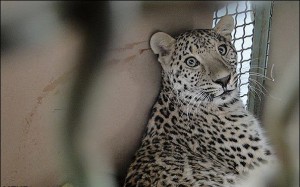 In the past 40 days alone, seven rare Persian leopards (Panthera pardus saxicolor) have been killed or injured by poachers, food poisoning and cars, according to Iranian media reports.
In the past 40 days alone, seven rare Persian leopards (Panthera pardus saxicolor) have been killed or injured by poachers, food poisoning and cars, according to Iranian media reports.The destiny of the leopard most recently harmed illustrates the cruelty of these incidents. The wretched cat was found in a forested area in the north of Iran with one front leg cut off by a foot-snare trap. After transporting the large male to a veterinary center, radiography showed that he was suffering from more than 50 small pellets and bullets scattered throughout its body and could not move due to spiral cord damage. There is no hope that the leopard�s condition will improve, according to an interview with its wildlife veterinarian.
The Persian leopard, as one of the mascots of the Sochi Olympics, is the largest member of the cat family in Iran. Due to differences in local environmental conditions there is a lot of variation in both the size and coloration of these animals. The type that inhabits the northern regions of Iran, specifically the montane forests of the Caspian region, is one of the largest leopards in the world. Its height at shoulder can measure up to 75 centimeters with a weight of up to 60-90 kg,�according to�the Encyclopedia Iranica. The Persian leopard is officially considered an endangered subspecies included on the Red List of the International Union for Conservation of Nature and Natural Resources (IUCN).
Despite being a flagship species, there is no reliable data about the population size, mortality or fertility rate of this powerful cat. In 2002, an�article�published in the journal,�Zoology in the Middle East, guesstimated that 550-850 individual leopards inhabited Iran, which is known as one of the strongholds for most of the remaining members of the subspecies. According to some reports, the population of the Persian leopard has drastically declined across its range, mainly because of the decimation or disappearance of ungulates, which are its main food source. And food scarcity increases the potential for conflict between humans and leopards.
A survey published in�Proceedings of the International Annual Symposium on Sustainability Science and Management�showed that 71 Persian leopards were killed by illegal hunting or poisoned between 2007 and 2011 (12 of the cats have been killed in the last 11 months alone, according to Iranian media), but such surveys only capture the tip of the iceberg. The actual number of killings is much higher than reported
Some national NGOs of Iran received technical and financial aid from international counterparts in order to carry out studies focusing on the Persian leopard. Some attempts at camera-trapping were carried out in order to estimate the population size of the leopard in different protected and non-protected areas. Also, awareness-raising programs have been conducted to increase local people�s attention to the role of the leopard in local ecosystems. For instance, an NGO investigated and�reported�that seven leopards inhabit the Bamu National Park in the Fars Province of Iran. The NGO also educated students who live in villages surrounding the park about the importance of saving the big, spotted cat. One of the important roles that the leopard plays is controlling the population size of Indian crested porcupine,�the biggest rodent in Iran, and wild boar, which might become pests of agriculture.
Recently, the Cat Specialist Group of IUCN assisted the Department of Environment of Iran (DoE) in the compilation of a booklet, titled �Conservation Cats of Iran � a roadmap to a comprehensive approach for the conservation of the indigenous cat species of the I.R. Iran.� The effort involved all Iranian NGOs focusing on the conservation of wild cats. Despite many useful hints regarding the collection of different types of data (via observations, genetics, camera-trapping and so on), there is no mention in the booklet on how to use or analyze the gathered data. It should be noted, however, that conservation and management plans cannot be implemented without reliable results derived from sound data analysis.
The DoE is the main government organization responsible for protecting and conserving wild animals, according to game and fishery law. It is clear that implementation of any conservation plan requires monitoring data regarding the target species, such as direct or indirect observation, and killed or alive sightings. However, it seems that the DoE has no systematic recording database to keep track of the number and type of leopard deaths, which include car crash, deliberate poisoning, or illegal hunting.
It may well be that the DoE has, in fact, gathered and recorded this data, but they are not available for public access due to lack of transparency in the government. This is regrettable because spatiotemporal analysis of data collected about killed leopards could provide realistic insights about the causes and circumstances behind these incidents. More specifically, results of such analysis could reveal critical spots and regions where human-species conflicts concentrate. Instead of the DoE, a few NGOs are gathering these data with the aim of identifying main zones of conflict.
Apparently, the fate of the Persian leopard depends on the outcomes of NGO efforts, on one hand, and on the application of derived analysis outcomes by the DoE, on the other hand. Hence, an important future consideration is how far the government organization continues to cooperate with non-governmental organizations in the effort to save these majestic cats.
This article was written by �Sam Khosravifard��for the opinion page of Scientific American�on February 7,2014.Sam Khosravifard has been working as a freelance journalist focusing on Iran�s wildlife and natural resources issues since 1997 . He is the author of two books, theNatural Heritage of Iran�and�Persian Lion of Iran.
The Iran Project is not responsible for the content of quoted articles.










